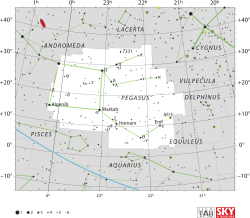Eta Pegasi

| |
| Observation data Epoch J2000.0 Equinox J2000.0 | |
|---|---|
| Constellation | Pegasus |
| Right ascension | 22h 43m 00.13743s[1] |
| Declination | +30° 13′ 16.4822″[1] |
| Apparent magnitude (V) | +2.95[2] |
| Characteristics | |
| Spectral type | G2 II + F0 V[3] |
| U−B color index | +0.57[2] |
| B−V color index | +0.86[2] |
| Astrometry | |
| Radial velocity (Rv) | +4.3[4] km/s |
| Proper motion (μ) | RA: –100.06[1] mas/yr Dec.: +15.46[1] mas/yr |
| Parallax (π) | 19.51 ± 0.18[1] mas |
| Distance | 167 ± 2 ly (51.3 ± 0.5 pc) |
| Absolute magnitude (MV) | –1.18[5] |
| Orbit[6] | |
| Period (P) | 813 days |
| Eccentricity (e) | 0.183 |
| Periastron epoch (T) | 2452025 HJD |
| Argument of periastron (ω) (secondary) | 344.7° |
| Semi-amplitude (K1) (primary) | 14.37 km/s |
| Details | |
| η Peg A | |
| Mass | 3.82 ± 0.52[7] M☉ |
| Radius | 18[8] R☉ |
| Luminosity | 247[7] L☉ |
| Surface gravity (log g) | 2.40[9] cgs |
| Temperature | 5,450[7] K |
| Metallicity [Fe/H] | +0.39[9] dex |
| Rotation | 818[5] |
| Rotational velocity (v sin i) | 1.4[6] km/s |
| Other designations | |
Eta Pegasi (η Pegasi, abbreviated Eta Peg, η Peg), also named Matar,[11] is a binary star in the constellation of Pegasus. The apparent visual magnitude of this star is +2.95,[2] making it the fifth-brightest member of Pegasus. Based upon parallax measurements, the distance to this star is about 167 light-years (51 parsecs) from the Sun.[1]
Nomenclature
η Pegasi (Latinised to Eta Pegasi) is the star's Bayer designation.
It bore the traditional name Matar, derived from the Arabic سعد المطر Al Saʽd al Maṭar, meaning lucky star of rain.[12] In 2016, the International Astronomical Union organized a Working Group on Star Names (WGSN)[13] to catalogue and standardize proper names for stars. The WGSN approved the name Matar for this star on 21 August 2016 and it is now so entered in the IAU Catalog of Star Names.[11]
Namesake
USS Matar (AK-119) was a United States Navy Crater class cargo ship named after the star.
Properties
The Eta Pegasi system consists of a pair of stars in a binary orbit with a period of 813 days and an eccentricity of 0.183.[6] The primary component is a bright giant star with a stellar classification of G2 II[3] and about four times the mass of the Sun.[5] The interferometry-measured angular diameter of this star, after correcting for limb darkening, is 3.26 ± 0.07 mas,[14] which, at its estimated distance, equates to a physical radius of nearly 18 times the radius of the Sun.[8] It is radiating 247[7] times the luminosity of the Sun from its expanded outer envelope at an effective temperature of 5,450 K.[7] The rotation rate of the star slowed as it expanded, so it has a projected rotational velocity of 1.7 km s−1 with an estimated rotation period of 818 days.[5]
The secondary component is an F-type main sequence star with a classification of F0 V.[3] There are also 2 class G stars further away that may or may not be physically related to the main pair.
References
- 1 2 3 4 5 6 van Leeuwen, F. (November 2007). "Validation of the new Hipparcos reduction". Astronomy and Astrophysics. 474 (2): 653–664. arXiv:0708.1752
 . Bibcode:2007A&A...474..653V. doi:10.1051/0004-6361:20078357.
. Bibcode:2007A&A...474..653V. doi:10.1051/0004-6361:20078357. - 1 2 3 4 Johnson, H. L.; et al. (1966). "UBVRIJKL photometry of the bright stars". Communications of the Lunar and Planetary Laboratory. 4 (99): 99. Bibcode:1966CoLPL...4...99J.
- 1 2 3 Parsons, Sidney B.; Ake, Thomas B. (November 1998), "Ultraviolet and Optical Studies of Binaries with Luminous Cool Primaries and Hot Companions. V. The Entire IUE Sample", The Astrophysical Journal Supplement Series, 119 (1): 83–104, Bibcode:1998ApJS..119...83P, doi:10.1086/313152
- ↑ Wilson, Ralph Elmer (1953). General Catalogue of Stellar Radial Velocities. Washington: Carnegie Institution of Washington. Bibcode:1953GCRV..C......0W.
- 1 2 3 4 Pizzolato, N.; Maggio, A.; Sciortino, S. (September 2000), "Evolution of X-ray activity of 1-3 Msun late-type stars in early post-main-sequence phases", Astronomy and Astrophysics, 361: 614–628, Bibcode:2000A&A...361..614P
- 1 2 3 Massarotti, Alessandro; et al. (January 2008), "Rotational and Radial Velocities for a Sample of 761 HIPPARCOS Giants and the Role of Binarity", The Astronomical Journal, 135 (1): 209–231, Bibcode:2008AJ....135..209M, doi:10.1088/0004-6256/135/1/209
- 1 2 3 4 5 Hohle, M. M.; Neuhäuser, R.; Schutz, B. F. (April 2010), "Masses and luminosities of O- and B-type stars and red supergiants", Astronomische Nachrichten, 331 (4): 349, arXiv:1003.2335
 , Bibcode:2010AN....331..349H, doi:10.1002/asna.200911355
, Bibcode:2010AN....331..349H, doi:10.1002/asna.200911355 - 1 2 Lang, Kenneth R. (2006), Astrophysical formulae, Astronomy and astrophysics library, 1 (3 ed.), Birkhäuser, ISBN 3-540-29692-1. The radius (R*) is given by:
- 1 2 Luck, R. Earle; Wepfer, Gordon G. (November 1995), "Chemical Abundances for F and G Luminosity Class II Stars", Astronomical Journal, 110: 2425, Bibcode:1995AJ....110.2425L, doi:10.1086/117702
- ↑ "MATAR -- Star in double system", SIMBAD Astronomical Object Database, Centre de Données astronomiques de Strasbourg, retrieved 2012-03-03
- 1 2 "IAU Catalog of Star Names". Retrieved 28 July 2016.
- ↑ Davis, George R., Jr. (1944), "The pronunciations, derivations, and meanings of a selected list of star names", Popular Astronomy, 52: 8, Bibcode:1944PA.....52....8D
- ↑ IAU Working Group on Star Names (WGSN), International Astronomical Union, retrieved 22 May 2016.
- ↑ Richichi, A.; Percheron, I.; Khristoforova, M. (February 2005), "CHARM2: An updated Catalog of High Angular Resolution Measurements", Astronomy and Astrophysics, 431 (2): 773–777, Bibcode:2005A&A...431..773R, doi:10.1051/0004-6361:20042039